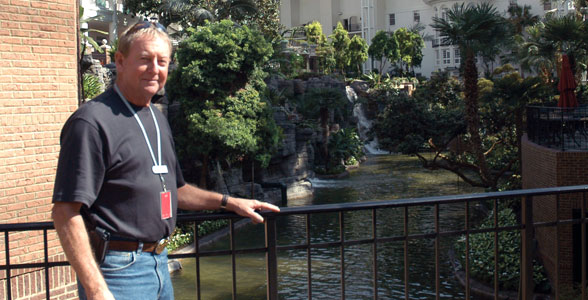By Patricia McDaniels
From its modest beginnings in 1977 as a 600-room hotel built to support a music-based theme park, the Opryland Hotel in Nashville, Tennessee, has grown into a world-renowned first-class conference hotel and attraction in its own right. The hotel, situated near the Cumberland River, boasts 2,881 rooms and not one, not two, but three iconic conservatories.
Hollis Malone is a 1970 graduate of the College of Agriculture, now known as the College of Agricultural Sciences and Natural Resources in the Institute of Agriculture. He has spent 38 years as the chief horticulturalist for Opryland USA and subsequently for the Gaylord Opryland Hotel. He met with the original architects and worked with them to create a unique indoor landscape that would captivate hotel guests. He picked out and planted the palm trees and plants for which the original Conservatory won international acclaim. (It was designated as an indoor arboretum by the Nashville Tree Foundation for its unique collection, including 63 palm varieties.) Malone also designed the landscaping for both of the hotel’s newer wings, the Cascades and the Delta.
On May 3, 2010, when Malone headed off to work, he wondered how much of his life’s work was left. He knew a minimum of 10 feet of contaminated floodwaters covered parts of the hotel and the surrounding grounds because during the height of the storm, he had helped evacuate guests from the massive property. He guessed renovations would cost millions.
About $170 million at last count, but the final cost is likely incalculable as more than 1,700 employees temporarily lost their jobs while the hotel was being renovated. Malone, however, and his team of 43 stars from the Horticulture Department stayed employed. (Gaylord Resorts calls its employees “stars.”) Their work was considered crucial to the renovation. The hotel’s management was determined to reopen the venue for the 2010 holiday season.
In the days and weeks following the flood, the hotel was drained and damage assessed. Malone learned that many of the plants in the indoor landscapes survived. Most of the trees apparently enjoyed the experience, he joked. But some of the damage wasn’t readily apparent to the human eye. “Even though some of the plants survived, we had to replace all the soil that was under water. It was contaminated with all sorts of chemicals and materials brought in with the flood. We didn’t want to expose our guests and employees to the contamination, so we replaced about three-thousand cubic yards of soil with a special soil mix for tropicals. The plants that could be salvaged were bathed and bathed and bathed again to cleanse them of residues.”
Replacing contaminated soil was just one stretch of the long road that Malone and his stars walked to ready the hotel for reopening. The first order of business was to determine whether any tweaks to the landscape design were desirable and feasible.
“In a way, the flood was a golden opportunity to revisit the design of the plantings that were damaged and invest in newer, more appealing foliage and blooms,” Malone says. “We’ve added more tropical plants and more color to the new interiorscape with cultivars that weren’t available during the original installation.”
Malone is grateful to the “guys from engineering” who helped make his office one of the first to become fully functional after the flood. “They installed shelving for my reference books and an all-important drawing board on which I drafted the new designs,” he says. “I confess — it was a little scary ‘reselling’ my ideas to management at my age.” He says the faculty of the Plant Sciences Department, and particularly the folks at the UT Gardens, have been helpful to him throughout his career, and he drew upon all his knowledge to present management with landscape updates and modifications that he believed would make the guest experience more enjoyable. His pitch worked, and visitors to the renovated hotel now see many new plants that were not featured before the flood.
Even dealing with the aftermath of a disaster, Malone loves his job. “It’s not everyone who is fortunate enough to make a career out of their hobby,” he says. “I love creating quality experiences for the people who come to enjoy the hotel.” With a proud twinkle in his eye, Malone adds — millennial disasters notwithstanding — “No matter what it’s like outside, it’s always a great day in here.”
Photography courtesy of Gaylord Opryland Resort. To see images of the hotel’s restoration, go to www.gaylordhotels.com/gaylord-opryland or www.facebook.com/gaylordoprylandresort.



